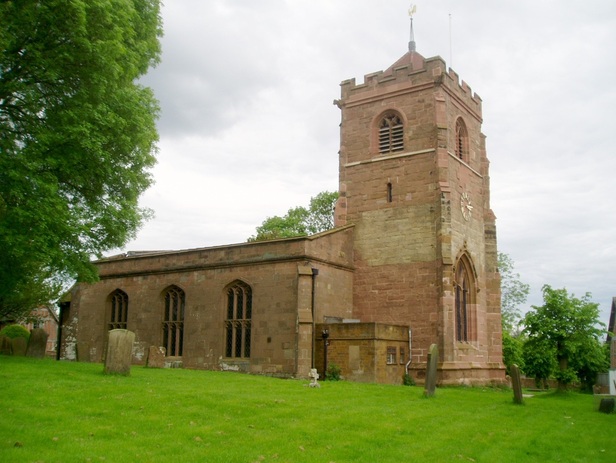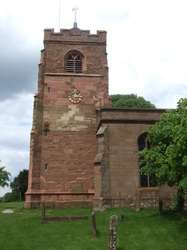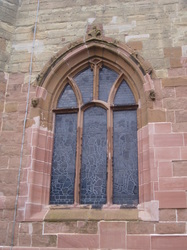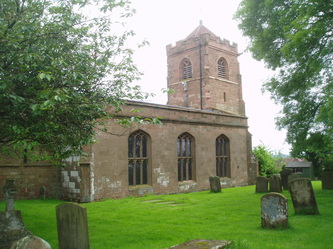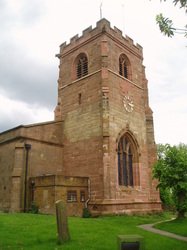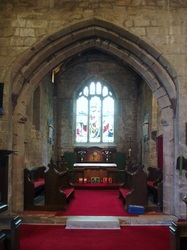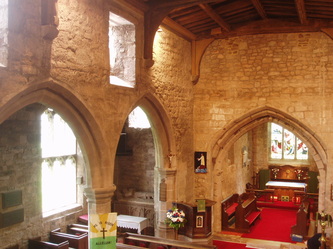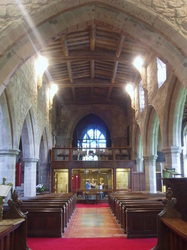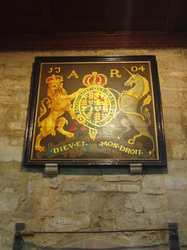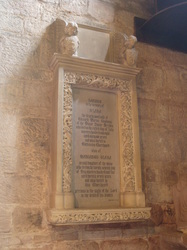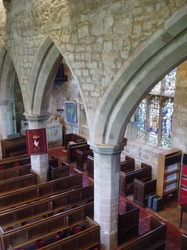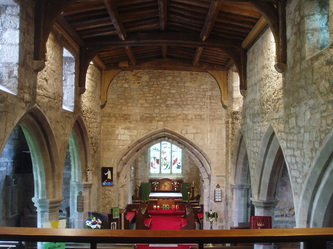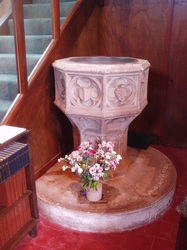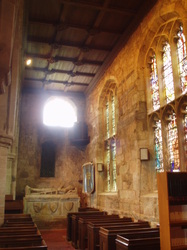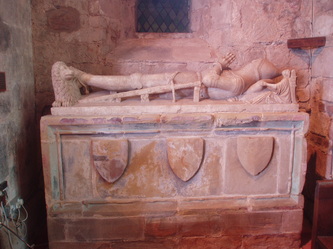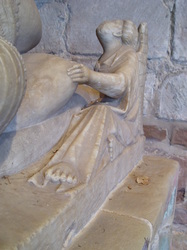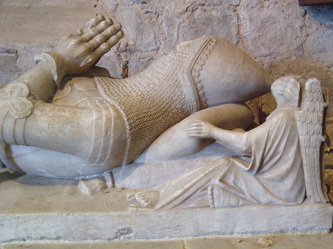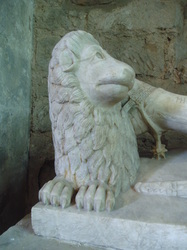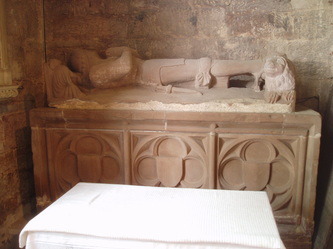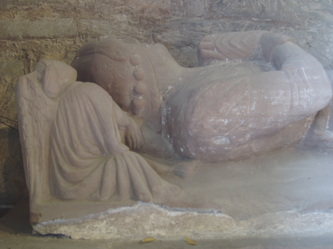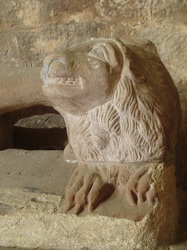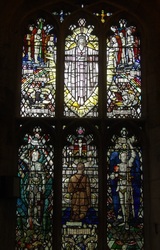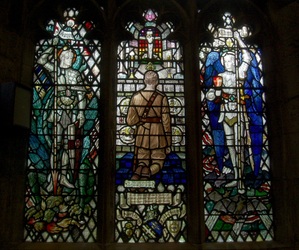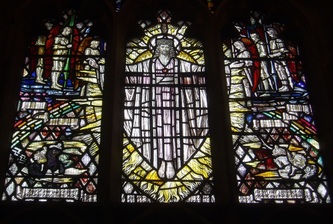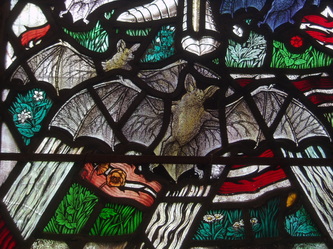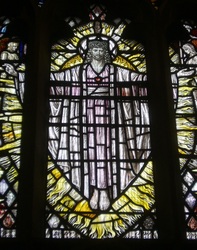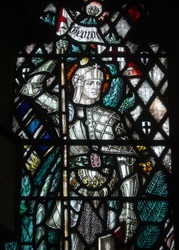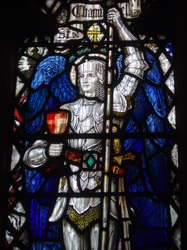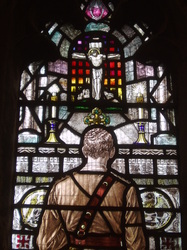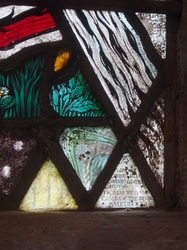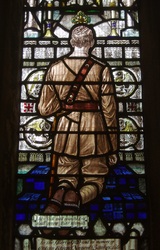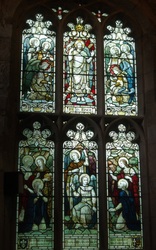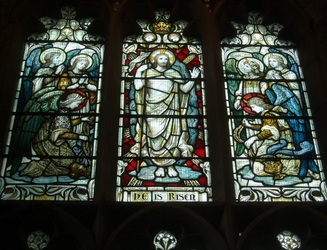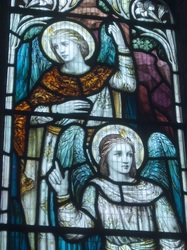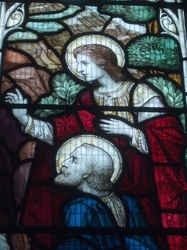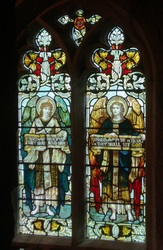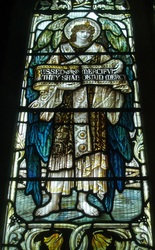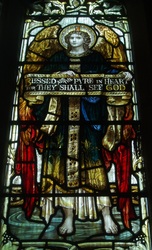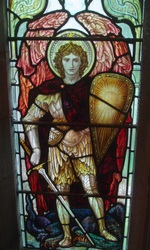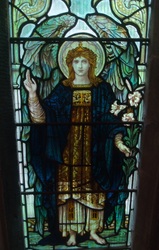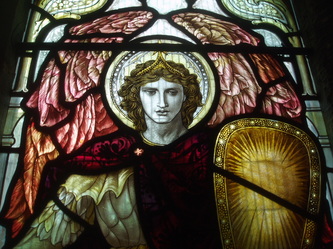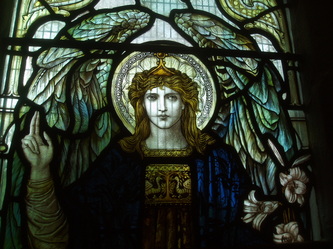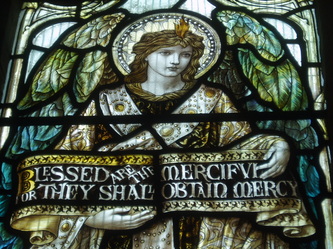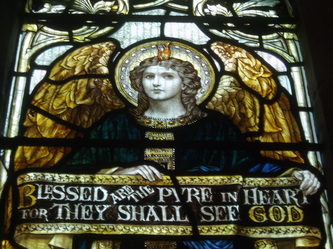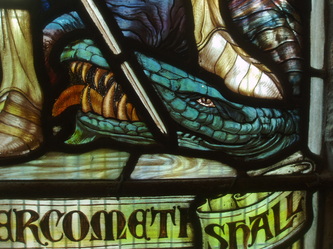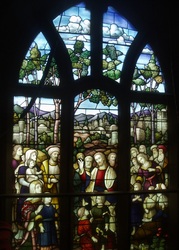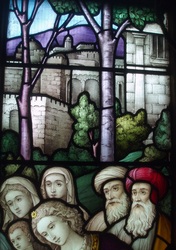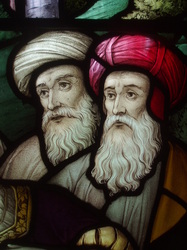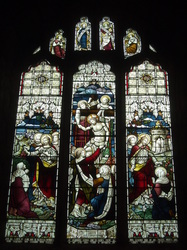Meriden - St Laurence
Meriden has a claim to being the centre point of England, which is traditionally marked by the medieval cross shaft that stands at the heart of the modern village. It's ancient church of St Laurence is one I'd long neglected to visit, but had heard good things about (with regard to the glass) from some friends who were engaged on some recent restoration there. I expected it to be locked and difficult to access, but having stumbled across a reference online stating it was open on sunday afternoons I decided to make plans.
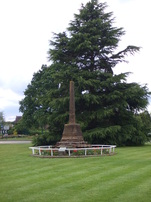
The Centre Point of England
Cycling through Meriden revealed little of historic note (beyond the ancient obelisk that traditionally marks the centrepoint of England) until I was almost out the far side of it, and then glimpsed the distant red sandstone tower on a hill, which is where travel by bike becomes a real disadvantage! The church stands outside the village on a hill top some distance to the east. Built of a warm red sandstone, it consists of a late 15th
century west tower, a Norman chancel and an aisled nave, largely 13th century in date though the outer walls of the aisles betray a thorough remodelling in the early 19th century. The exterior was otherwise a little hard to appreciate from the south due to a lush avenue of trees lining the path to the south door, the aisles with their large three light windows look early 19th century, but the masonry within suggests this is the result of remodelling rather than rebuilding.
I imagined a church with limited open hours would be manned, and sure enough I could hear two ladies talking as I reached the south door, one of whom kindly offered me a drink the moment I entered, which was hugely appreciated following that slog up the hill! I often worry about turning up armed with camera and tripod as some people can be quite suspicious about such things, but no problems here, this was true Christian charity and Meriden's parishoners are to be warmly commended for the welcome they give their visitors.
century west tower, a Norman chancel and an aisled nave, largely 13th century in date though the outer walls of the aisles betray a thorough remodelling in the early 19th century. The exterior was otherwise a little hard to appreciate from the south due to a lush avenue of trees lining the path to the south door, the aisles with their large three light windows look early 19th century, but the masonry within suggests this is the result of remodelling rather than rebuilding.
I imagined a church with limited open hours would be manned, and sure enough I could hear two ladies talking as I reached the south door, one of whom kindly offered me a drink the moment I entered, which was hugely appreciated following that slog up the hill! I often worry about turning up armed with camera and tripod as some people can be quite suspicious about such things, but no problems here, this was true Christian charity and Meriden's parishoners are to be warmly commended for the welcome they give their visitors.
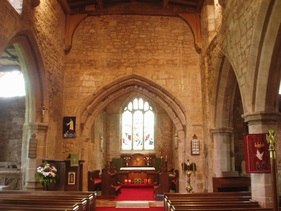
The interior retains a feel of antiquity despite various restorations (including much recent renovation of the nave roof and the insertion of a meeting room and gallery at the west end) and contains several items of historic interest, including a Royal Arms of Queen Anne (1704) above the south door, and two 15th century knight's effigies placed at the ends of the side aisles (that on the south side being particularly fine).
The walls were scraped in the 19th century to reveal the bare stonework (a common practice, but a distorted vision, the walls would have originally been limewashed and coloured with mural decoration).
The walls were scraped in the 19th century to reveal the bare stonework (a common practice, but a distorted vision, the walls would have originally been limewashed and coloured with mural decoration).
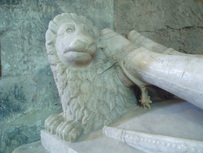
The effigy at the east end of the south aisle is a superb example of early 15th century alabaster sculpture and a well detailed representation of contemporary armour (spurs, scabbard and gauntlets all beautifully rendered) and is believed to represent Sir John Wyard and date to c1404. Angels flank the knight's pillow (normally these suffer damage or defacement over the centuries, but here they are intact) and a very tame looking lion serves as a footrest.
The identity of the knight in the corresponding position in the north aisle is unknown, he dates from c1460 and is carved from red sandstone, and of lesser quality despite being similarly replete with angels and lion (this one a more stodgy, comical beast!)
The identity of the knight in the corresponding position in the north aisle is unknown, he dates from c1460 and is carved from red sandstone, and of lesser quality despite being similarly replete with angels and lion (this one a more stodgy, comical beast!)
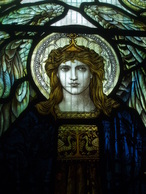
The east window is a rather dull affair by Heaton, Butler & Bayne, but there is some particularly fine stained glass in the south aisle, with two beautiful windows by Powell's in their later Pre-Raphaelite-influenced style, and a sumptuously detailed war-memorial window by Camm's of Smethwick. The glass at the west end can be studied from close
quarters from the recently installed gallery, particularly the west window (with
it's strange simplified tracery, clearly reworked in the 17th century or later)
which looks like the work of Lavers & Westlake.
The finest window here in my opinion is the Camm's War memorial window, depicting in it's lower half a soldier kneeling in prayer flanked by warriors with a radiant Christ in majesty above, a real tour de force and superb example of the work of Florence Camm, filled with lush detail and exotic beats (such as bats and a dragon at the base depicting forces of darkness, with the Four Horsemen of the Apocalypse against a rainbow above). The nearby Powell's window portraying four exquisite angels comes a close second.
quarters from the recently installed gallery, particularly the west window (with
it's strange simplified tracery, clearly reworked in the 17th century or later)
which looks like the work of Lavers & Westlake.
The finest window here in my opinion is the Camm's War memorial window, depicting in it's lower half a soldier kneeling in prayer flanked by warriors with a radiant Christ in majesty above, a real tour de force and superb example of the work of Florence Camm, filled with lush detail and exotic beats (such as bats and a dragon at the base depicting forces of darkness, with the Four Horsemen of the Apocalypse against a rainbow above). The nearby Powell's window portraying four exquisite angels comes a close second.
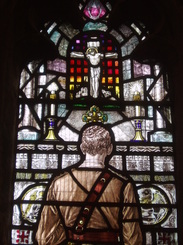
The church is normally kept locked, but is open on Sunday afternoons from Easter
to October and visitors are made very welcome.
There are also very occasional opportunities to climb the church tower for excellent views of the surrounding countryside, but alas I missed the latest opening by a week!
http://www.stlaurence-meriden.co.uk/
Photos & Text copyright of Aidan McRae Thomson 2012
to October and visitors are made very welcome.
There are also very occasional opportunities to climb the church tower for excellent views of the surrounding countryside, but alas I missed the latest opening by a week!
http://www.stlaurence-meriden.co.uk/
Photos & Text copyright of Aidan McRae Thomson 2012
